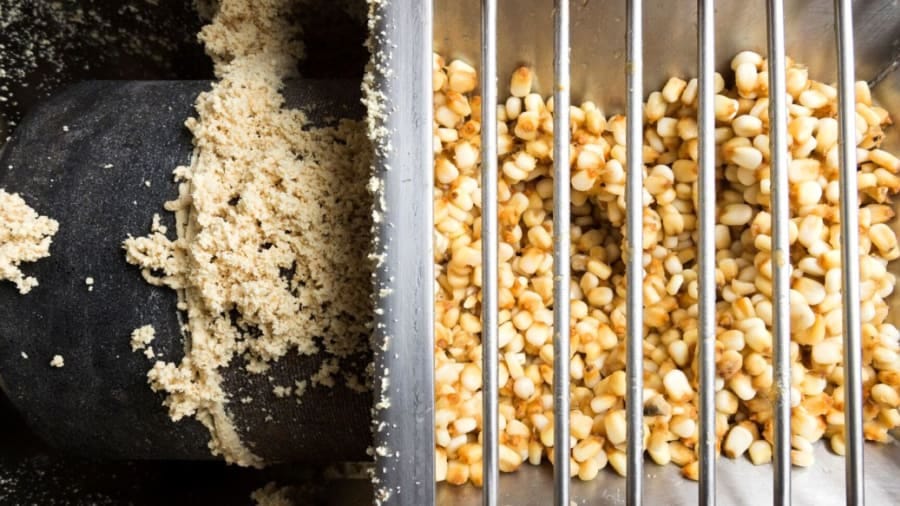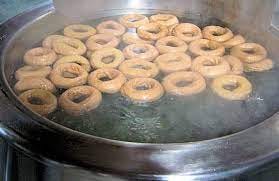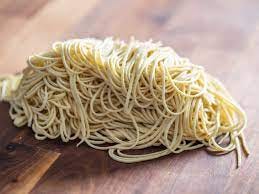Greetings from Mexico City, where my diet is 30% nixtamalized.
It’s been a couple of months since we dug into a specific food. Classics of the genre include Mortadella and the Sumo Orange. Today, we are considering a process that transforms humble ingredients into something that has sustained civilizations. Nixtamalization is the building block of some of the world’s favourite snacks, from pretzels to ramen noodles to corn tortillas.
Design
Since it was the inspiration for this post, today we are going to focus primarily on the nixtamalization process used to make corn tortillas. To preserve corn (maize) kernels beyond the season, farmers leave the ears of corn out to dry. Dried corn kernels are not particularly appetizing and when ground, they are hard to turn into flour or anything else. Nixtamalization is the process that turns dried corn into something magical. The grains are soaked in an alkali water mixture for around 30 minutes. Alkali water is water with a high pH level of 12+.
The most common grain used is maize. Maize is different from the corn we know today. It was “engineered” over hundreds of years from domesticated grass to encourage the kernels to grow in size. When adapted to Europe, it took a turn and the kernels got even sweeter. The proper pH level of the nixtamalization mixture is dependent on the type of grain, and even as specific as the sub-varietal. Mexican corn requires a different pH than an equivalent American breed. The mixture is made by combining lye (or calcium hydroxidel) and water.
The process of nixtamalization was developed by Mesoamericans more than 3,500 years ago. It happens by combining water, wood ash and dried corn husks, then letting it all sit overnight. The wood ash is where the process gets it name: the word combines nahuatl nextli which means lime from ashes, with tamalli, cooked corn dough. Nixtamalization basically translates to "ash and dough".
The lye soak and cooking serves multiple purposes: it kills common corn fungi, softens the husks to make for easier processing and releases key nutrients from the grains (making the end product healthier). The end product (which, in the case of corn is called masa) contains 13 times more calcium than the maize itself before nixtamalization, and can even function as your main source of calcium. Combined with beans, masa becomes a complete protein and has all the amino acids necessary for our diets. Can someone please develop the process to nixtamalize French fries and gummy bears?
When the Spaniards arrived in Mexico, they took corn back with them but did not take back the secrets of the nixtamalization process. Classic colonial behaviour. Why bother reading the instructions? I can figure this out. Without the key nutrients from the processing, the Spaniards were prone to a disease called pellagra, which causes insomnia and sensitivity to light. Did people with pellagra inspire vampire fiction? Some people think so!
Masa is not a shelf stable ingredient, resulting in a need to nixtamalize almost daily or to freeze batches. If you compare the end products of nixtamalized foods (tortillas, tamales, etc.), they have different colour, flavour and smell compared to other corn-based pastries. In fact, if you tried to make tortillas with regular corn meal or polenta, you would fail. If you have ever had hominy grits, that is also a nixtamalized corn product.
The process can be applied to other fruits and vegetables (although most chefs do not deviate). At Elena Reygadas’s Mexico City institution Rosetta she serves a nixtamalized citrus desert. You can nixtamalize gourds, or anything really. The process has had a big resurgence. You can even do it at home. In most cities with Latin American populations, you can find local tortillerias or businesses processing their own maize. It is worth trying multiple to taste the difference!
Innovation
The use of alkali baths in cooking extends way beyond Mexico and South America. As a lover of all baked goods, I was shocked when I first learned that pretzels and bagels were dunked in lye! Isn’t that poison? Isn’t that the stuff you pour into bathtubs to dissolve bodies on mob dramas? WAIT, it is also in some of my most beloved noodle types?
For a number of baked goods, a lye soak is part of the preparation. Originally done by soaking hardwood ash in a bucket of water, commercially produced “food grade” lye is much more common. Bakers create a bath at very high pH levels (up to 14, anything above 12 can burn your skin). For pretzels, it is a quick dunk and for bagels it is a short boil. This is dangerous stuff! If you use a copper pot (or anything other than stainless, really) the lye becomes poisonous.
So why do we take the risk of dunking our dough in drain-o? When you bake bread, the heat interacts with the sugars and makes a yummy crust. The lye breaks down the proteins in the dough further and in different ways, which creates the unique types of textures and crusts that you get in pretzels and bagels.
Ramen also benefits from alkalization. The yellowy colour and “snap” are evidence of noodles that include alkali substances. The process is called Kansui. It often comes in the form of a powder added to the water that is then incorporated into dough. From Sho Spaeth’s ramen recipe on Serious Eats:
The noodles' alkalinity is what gives ramen that distinctive slippery quality, and contributes to the glossiness of the noodles' exterior, both of which are also phenomena evident in dried pasta noodles that undergo the so-called "ramenization" process. But the alkaline salts also contribute a specific flavor, produced by the interaction with the wheat, familiar to anyone who has eaten any ramen of any kind.
Cost
You can get good tortillas for less than $10/kilo, bagels for $2/bagel and Sun Noodles for $1.50/serving. At those prices, if you come across a nixtamalized product, it is worth a try!
PS
I will never understand the claims that New York has the best bagels. To me, they are just oversized roles. Here is a great clip from Utopia Bagels in NYC perpetuating this falsehood.
The only real bagels are Montreal Bagels. That is why the world record for eating bagels (61 in one sitting) was done with Montreal Bagels. No one wants to eat 61 New York bagels, ever.










I learned a new word! Who knew? Very interesting…😍
NYC bagel is better only in the form of a sandwich with lox and cream cheese. Big hole in MTL bagel makes it a poor vessel for a sandwich with cream cheese. The bagels themselves though, it's no contest. I have never seen anyone eat in bagel plan in NYC but MTL bagel are great by themselves.